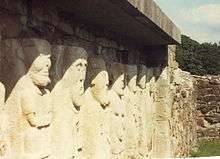White Island, County Fermanagh

White Island is an island in Lower Lough Erne, County Fermanagh, Northern Ireland. It is situated in Castle Archdale Bay off the east shore of Lower Lough Erne. The ruins of an ancient church are found near the shore, built on the site of an earlier monastic settlement. It still has an intact arched Romanesque doorway. The Church and carved figures are State Care Historic Monuments sited in the townland of White Island, in Fermanagh District Council area, at grid ref: H1753 6000.[1] The rath, earthwork and area surrounding the state care monument are Scheduled Historic Monuments, at grid ref: H1753 6000.[2] The island is accessed by ferry from the marina in Castle Archdale Country Park, near Irvinestown. Location: Open Street Map Reference
Features
The ruined church on the island has a reconstructed plain Romanesque doorway. Secured to the north side of the south wall are eight carvings (seven figures and one head) built into the masonry of the church.[3] Most of the figures were carved wearing the long tunics of churchmen. They are all carved in quartzite and were probably constructed between 800 and 1000, and were later used as building stones in the church, before being uncovered in recent centuries. Helen Hickey has identified them as three pairs of caryatids. Each pair a different height and suggests that because of the sockets on the top of their heads that they may have supported a pulpit or preaching chair of an earlier possible wooden church. One popular theory is that the figures illustrate an episode in the life of St. Patrick, when Patrick heals a local King. This event is linked strongly with the Cathedral in Armagh, Northern Ireland.
There are eight figures in all, including an uncarved figure, suggesting the figures were carved on-site, and a frowning face, or "mask". From left to right, the figures are as follows:
- The first figure is presumed to be a Sheela na Gig - a statue of a grinning, naked female figure with its hands resting on its thighs. However the gender of the figure cannot be completely discerned from the carving, due to the lack of detail. Known to archaeologists as an 'exhibitionist figure', 'Sheelas' are common throughout Ireland as a supposedly magical creature, and are often found over church doorways and windows.
- The second figure is a seated figure, presumed to represent a Christ figure. It is similar to a representation of a seated Christ in the Book of Kells, supporting Hickey’s view that the figures supported an Ambro (lectern or pulpit used by clergy to proclaim the Gospel).
- The third figure is supposedly an abbot, or similarly highly ranking clerical figure. It is hooded, and holding a crook and a bell.
- The fourth figure is possibly David with hand pointing to his mouth. This is a reference to David’s role as a psalmist. This figure is shown to be holding a scroll, and has a pouch hanging from its belt.
- The fifth and sixth figures were identified by Hickey as 'Christ with Griffins' and 'Christ the warrior with sword & shield', respectively. The sixth figure is shown to be wearing a penannular brooch of 9th or 10th century fashion.
- The seventh figure is uncarved, and thus blank, and the eighth figure is a frowning head.
An inscribed cross-carved stone was discovered built into the wall around the church.[3]
History
It is recorded in the Annals that the Vikings attacked and destroyed the monasteries in Lough Erne in A.D.837. For at least 400 years therefore these carvings may have laid in the ruins before a stone Romanesque style church was built.
See also
References
- ↑ "White Island" (PDF). Environment and Heritage Service - State Care Historic Monuments. Retrieved 2007-12-03.
- ↑ "White Island" (PDF). Environment and Heritage Service NI - Scheduled Historic Monuments. Retrieved 2007-12-03.
- 1 2 Weir, A (1980). Early Ireland. A Field Guide. Belfast: Blackstaff Press. p. 147.
External links
Coordinates: 54°29′20″N 7°44′10″W / 54.48879°N 7.73618°W